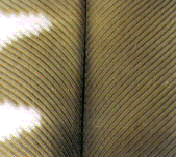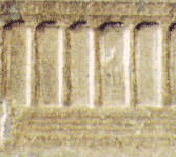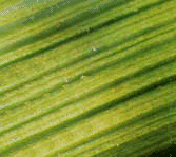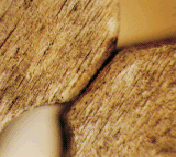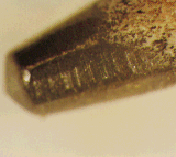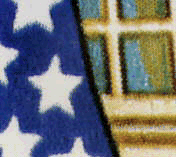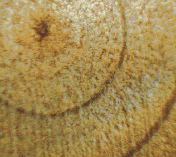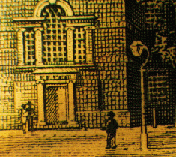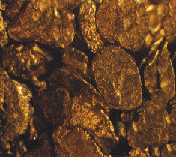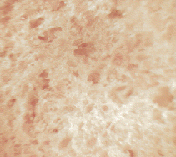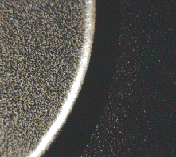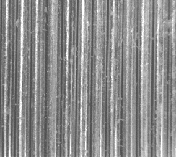Board Certified Forensic Document Examiner specializing in handwriting identification and suspect documents.
Emily J. Will, D-BFDE
Introduction
Handwriting is only one aspect of the work of a forensic document examiner. With the aid of specialized devices, many hidden artifacts become visible. The equipment enables the examiner to see things, but it is knowledge and experience that allow the examiner to interpret the findings correctly and to understand any limitations in the specific case at hand.
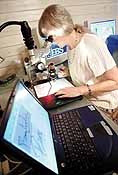
Magnifiers

Eventually I purchased a digital camera and tried the camera with the magnifier. And again it was a perfect match. This might not work with every digital camera. The one I use has a 10X optical zoom resulting in a lot of flexibility.
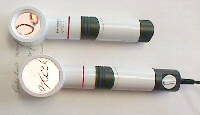
Everything that you see here has been tested in my office and found to be useful for document examination. Of course, if you are a stamp or coin collector, electronic assembler, or just like to examine life closely, you will find these products interesting. Please feel free to call 919-556-7414 or email me with your comments or questions. And remember that if a picture is worth a thousand words, a well-lit, magnified image speaks volumes.
Shedding Some Light on Your Document Problems
The illuminated magnifier I use so much is actually part of a system of illuminated magnification products by Eschenbach. There are several types of magnifiers available. A stand magnifier is excellent for any type of work because the magnifier body is its own stand. Your hands are free for other tasks.
Illuminated stand magnifiers have two parts - the head and the handle. The head is a circular or rectangular unit which consists of a housing and the magnifying lens. I prefer the round head because camera lenses are round. There are heads available at several magnifications (3X, 4X, 5X, 6X, 7.5X, 10X, 12.5X).
According to the laws of optics, as magnification increases, the field of view decreases. Also, as powers of magnification increase, there is some distortion as you look away from the center of the lens. Eschenbach minimizes this distortion by using a lens with aspheric curvature. But the price of using an aspheric lens is that the eye must be at a specific working distance from the lens to avoid the distortion.
After a thorough examination of the various lenses available, the ones I find most useful are 4X and 7X. The 4X head has a comfortable working distance and a useful field size. With either a 35 mm camera plus extension ring or a digital camera plus zoom, the 4X yields good detailed photos. For those situations where a closer image is needed, the 7X head is my choice. The heads are fully interchangeable. No matter what handle you decide on, any head will match. If you have several heads and just one handle, and the net result is that you have several magnifiers. The images be low were taken with increasingly stronger magnifiers - 4X, 7X and 10X.
Illuminated stand magnifiers have two parts - the head and the handle. The head is a circular or rectangular unit which consists of a housing and the magnifying lens. I prefer the round head because camera lenses are round. There are heads available at several magnifications (3X, 4X, 5X, 6X, 7.5X, 10X, 12.5X).
According to the laws of optics, as magnification increases, the field of view decreases. Also, as powers of magnification increase, there is some distortion as you look away from the center of the lens. Eschenbach minimizes this distortion by using a lens with aspheric curvature. But the price of using an aspheric lens is that the eye must be at a specific working distance from the lens to avoid the distortion.
After a thorough examination of the various lenses available, the ones I find most useful are 4X and 7X. The 4X head has a comfortable working distance and a useful field size. With either a 35 mm camera plus extension ring or a digital camera plus zoom, the 4X yields good detailed photos. For those situations where a closer image is needed, the 7X head is my choice. The heads are fully interchangeable. No matter what handle you decide on, any head will match. If you have several heads and just one handle, and the net result is that you have several magnifiers. The images be low were taken with increasingly stronger magnifiers - 4X, 7X and 10X.
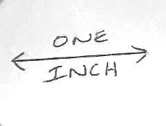
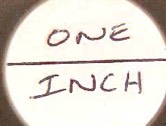

The second part of the magnifier is the handle. The handle is designed so that when it is connected to the head the entire unit will lie flat on a table to form its own stand. Three types of handle are available: an incandescent battery handle, and a halogen handle, and an LED handle. The bulb types are NOT interchangeable on the handles. The electrical assemblies of the handles are specific to the type of bulb.
A halogen bulb is whiter, brighter, and draws more power than an incandescent bulb. This need for power is the reason that the halogen handle sports a 110-120V power cord. There is actually another option - a halogen battery handle, but it is suggested that it be purchased as a companion to the plug-in handle for use only in special situations. It requires three C size batteries which last approximately three hours.
The incandescent battery handle requires two C batteries which last much longer. Rechargeable batteries can be used in either handle.
The LED handle has the advantage that the LED lamps should not need to be replaced (whereas bulbs burn out and need periodic replacement), and the battery life is extended. However, for document examination, there is no IR content in the illumination, and therefore the LED magnifier is not useful for use with IR filters.
A halogen bulb is whiter, brighter, and draws more power than an incandescent bulb. This need for power is the reason that the halogen handle sports a 110-120V power cord. There is actually another option - a halogen battery handle, but it is suggested that it be purchased as a companion to the plug-in handle for use only in special situations. It requires three C size batteries which last approximately three hours.
The incandescent battery handle requires two C batteries which last much longer. Rechargeable batteries can be used in either handle.
The LED handle has the advantage that the LED lamps should not need to be replaced (whereas bulbs burn out and need periodic replacement), and the battery life is extended. However, for document examination, there is no IR content in the illumination, and therefore the LED magnifier is not useful for use with IR filters.
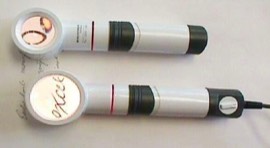
To summarize, my personal favorites are the 4X and 7X heads. I now own both and select one to use depending on whether fine detail or breadth of field is more important in what I need to see/photograph. If you are purchasing one handle only, consider a plug-in halogen. I find the halogen bulb to be more enlightening - both for the eye and for the camera.
A battery handle is great to have in certain circumstances. You can economize by selecting an incandescent, or you can select a battery halogen if you prefer the brighter light.
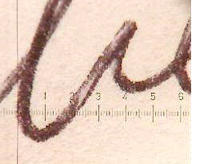
If you need to make careful, distortion-free measurements, Eschenbach offers Precision Scale Magnifiers that accept interchangeable measuring scales. The Precision Scale Magnifiers are available at 7x and 10x. The 7x is most versitile for document examination. Each unit has a clear plastic base which allows light into the field. An option is to combine the unit with an adaptive head that allows the scale magnifier to be used with any of the illuminated handles. Several scales are available. My two favorites are the linear scale and the combination scale. This 7X Precision Scale Magnifier (right)is fitted with a linear scale that is marked in tenths of a millimeter. The combination scale offers several useful measurement options.

Eschenbach is a German company that has been manufacturing precision optics for over 80 years. Eschenbach producst are carefully designed and engineered to be easy and comfortable to use. Each feature has been maximized for its purpose.Lenses are manufactured from a proprietary compound, PXM®, which has the same optical qualities as glass, but is lighter and more resistant to breaking. Together with the Frauenhofer Institute for Silicate Research, Eschenbach has developed a new coating for the PMX® lenses called cera-tec® which significantly improves scratch resistance. When ANSI (American National Standards Institute) decided to publish standards for Magnification, Eschenbach was on the development team. If you appreciate good tools, you will enjoy working with any Eschenbach product.
Contact:
Emily Will
P.O. Box 58552
Raleigh, NC 27658
Ph: 919-556-7414
Email: ewill@Qdewill.com
Microscopes
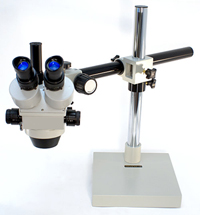

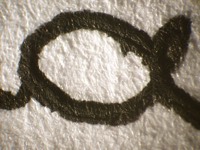
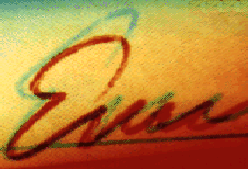
One enjoyable fringe benefit of being a document examiner is recreational use of the microscope. Over the years I have looked at and photographed lots of interesting things through the looking glass. Below are 6 reasonably common items photographed at varying powers. See if you can discern what they are. To check your answer, hover your mouse over each image.
Infrared/Ultraviolet


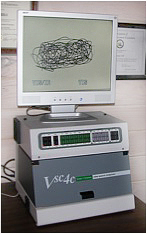
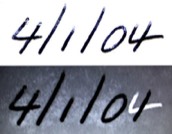
This demonstration parallels many cases in which additions to documents can be detected by the use of Infrared absorption or luminescence examination.
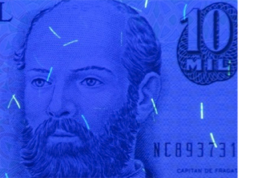
Indented Writing
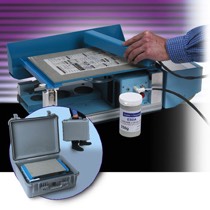

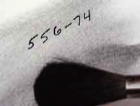
Next, a special toner powder is sprinkled over the protected document and the toner is drawn into the indentations on the document, making them visible. If indentations are revealed the results can be photographed. The toner is sandwiched between plastic and does not touch the paper.
